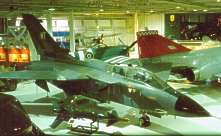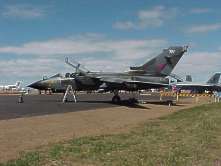 |
Tornado prototype, on display in
the RAF Museum, Hendon (picture supplied by Stef De Wit) |
Panavia Tornado
During the late sixties, European air forces wanted to gain some independence from American-supplied arms. One of the reasons for this was the feeling that a possible European war theatre would need very different aircraft than what the US was developing. Several nations drew up their requirement for both fighters and fighter-bombers. It was realised that these requirements could be met by one basic type, but development costs would be way too high for just one aircraft manufacturer. British Aircraft Corporation (later to become British Aerospace), Aeritalia and a German consortium of aircraft companies joined forces and formed Panavia. The 3 main companies backed by their respective governments would finance the whole project. This new European company would develop a Multi-Role Combat Aircraft (MRCA), later named the Tornado. Main mission of this aircraft would be ground attack, although a dedicated fighter interceptor version was also envisaged. To provide as much versatility as possible, the Tornado was designed from the outset as a swing-wing aircraft (to enhance low speed flying qualities). A second crewmember was deemed necessary for the imposing task of navigation and weapons management, the pilot being envisaged as being too much occupied in maneuvering around and over a confined European battle zone. Despite a rather long development period, test flying went remarkably well and the aircraft entered service in the three collaborating countries in due course. In Great Britain, the Tri-national Tornado Training Establishment was set up using aircraft of the 3 countries to speed up operation pilot training. Several of the Tornado's in use at the TTTE had the rear cockpit equipped for an instructor pilot rather than as a weapons and navigation office. Not much was left of the initial Multi-role concept, the production Tornado emerging as a true fighter-bomber. Great Britain still had a requirement for a true interceptor fighter however, and British Aerospace decided to develop this specific version for the RAF. The intermediate F.2 and final F.3 versions are recognizable immediately by their elongated (and elegant) noses. Saudi Arabia later became the first real export customer for the Tornado, ordering both ground attack and fighter versions. |
 |
Tornado prototype, an early
Airfix 1/72 rendering of an MRCA in high visibility test
flying colors (Airfix boxtop artwork - The Aviation Buffs Archives) |
 |
Tornado GR.1 on show at Avalon,
Australia, 2001 (picture used by kind permission of Darryl Gibbs, CNAPG) |
If you entered this page directly and want to check out the rest of my website : click here to go to my Homepage . |
Last update : 01-08-02 (c) Guido Van Roy